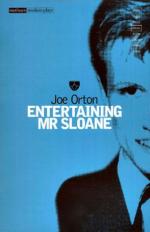|
This section contains 295 words (approx. 1 page at 400 words per page) |

|
Entertaining Mr. Sloane Summary & Study Guide Description
Entertaining Mr. Sloane Summary & Study Guide includes comprehensive information and analysis to help you understand the book. This study guide contains the following sections:
This detailed literature summary also contains Bibliography and a Free Quiz on Entertaining Mr. Sloane by Joe Orton.
Entertaining Mr. Sloane was Joe Orton's first full-length play and it initiated a meteoric, three-year career that established him as one of the most significant writers of stage farce m the twentieth century This exalted stature is now supported largely by two additional full-length plays-Loot (1965), and What the Butler Saw (produced posthumously in 1969)-and to a lesser extent by four one-act plays originally written for radio and television.
Entertaining Mr. Sloane opened in London in May of 1964 in a small "fringe" or off-Broadway like theatre. Its unconventional subject matter, explicit sexual themes, and coarse humor drew contradictory reviews, as did Orton's plays throughout his career. However, by the end of June, 1964, the controversial nature of the play helped catapult it into a major London theatre and Orton's short but brilliant career was launched. The most persuasive early praise came from the extremely popular but very conventional playwright, Sir Terence Rattigan, whose craftsman-like and conventional "well made" plays (dramatic works that have a distinct five act structure over which the plot logically unfolds) had dominated British commercial theatre from the 1930s until the late 1950s. Rattigan visited the production in its first week and ensured its transfer to a "West End" or Broadway-like theatre by investing a considerable amount of money in it himself. Controversial as the play was in both London and New York, Entertaining Mr. Sloane also enjoyed a German production and was soon slated for a film adaptation.
Clearly influenced in his earliest work by fellow British dramatist, Harold Pinter (The Homecoming), Orton gradually forged a distinct comic style that distanced his work from Pinter. As critics still speak of certain plays as picturesque, they now also refer to a farce that turns grotesque. explicitly sexual, and purposefully shocking as Ortonesque.
Read more from the Study Guide
|
This section contains 295 words (approx. 1 page at 400 words per page) |

|



